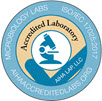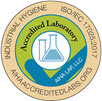Microplastics Testing
Contact: John Passero
1-800-220-3675 ext. 3604
jpassero@EMSL.com
Microplastics:
Microplastics are generally defined as polymeric particles smaller than 5 mm in size in any one dimension, present in wastewater, rivers, lakes and oceans. Polymers that are derived in nature that have not been chemically modified (other than by hydrolysis) are excluded. Due to the small size, they may not be easily removed during the wastewater filtration processes and can enter the ecosystem, negatively impacting the environment.
The common sources of microplastics are: additives in personal care products, synthetic fibers, resin pellets, tire recycling, medical products, abrasion and exfoliating beads used in furniture and insulation, fragments of larger plastic items as they degrade from the effects of ultraviolet rays and other weathering factors. Microplastics can potentially leach toxic chemicals, including endocrine disruption chemicals, such as bisphenol A and phthalates.
Microplastics Sampling:
Water samples may be collected in pre-cleaned 500 ml or 1 liter glass containers with non-plastic lid liners (PTFE is acceptable). Containers should be packaged to avoid breakage during shipment. The use of plastic packing peanuts should be avoided if possible. Shipping samples on ice (<6o) is preferred, but samples may be shipped at room temperature. Freezing of samples shall be avoided. A 28-day holding time from sample collection to the analysis is allowed.
Soils and similar solid samples may be collected by shovel or applicable device and placed into rinsed glass containers or jars. Whenever possible submit a minimum sample of approximately one liter in volume; however smaller amounts can also be analyzed when sample volume is limited. Beach sand is typically collected along the wrack line which is the point of high tide where sticks and other debris accumulate. This is also the point where the highest concentration of Micro-plastics is usually found.
Food and beverage samples may be submitted in glass jars or, in the case of unopened food or beverages, in their original containers. Food and beverage samples should be shipped on ice (ice packs) in appropriate coolers for maintaining a cool environment during shipping.
Microplastics Analysis:
EMSL Analytical, Inc offers multiple reporting styles. The Basic Microplastics Analysis which includes total microplastics count and sizing information obtained by sieving (when applicable) and microscopy. The Full Microplastics Analysis includes the polymer identification with size separation based upon the types of plastics observed. This process is performed by sieving (when applicable), filtration, and analysis by microscopy and Fourier Transform Infrared Spectroscopy (FTIR). Macroplastics (size >5mm), if found during the analysis, are also reported for informational purposes but not included in the sizing data.
 Order Sampling Supplies
Order Sampling Supplies Request Pricing
Request Pricing Technical Questions
Technical Questions 24/7 Account Access
24/7 Account Access Email Us
Email Us







